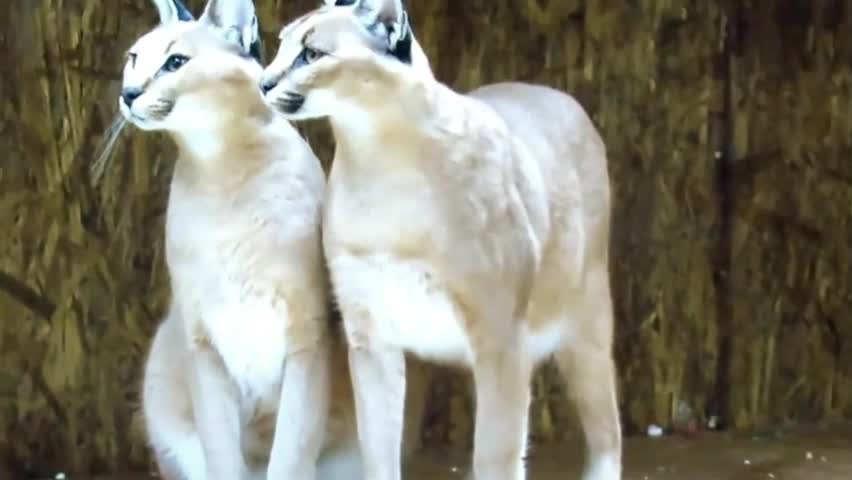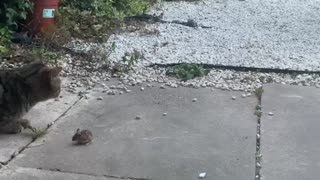Premium Only Content

watch this Caracal Wild Cat
watch this Caracal Wild Cat
The #caracal (Caracal caracal) is a medium-sized #wild #cat native to Africa, the Middle East, Central Asia and India. The caracal is characterized by a robust build, long legs, a short face, long tufted ears and long canine teeth. Its coat is uniformly reddish tan or sandy, while the ventral parts are lighter with small reddish markings. It reaches 40–50 cm (16–20 in) at the shoulder and weighs 8–18 kg (18–40 lb). It was first scientifically described by German naturalist Johann Christian Daniel von Schreber in 1777. Eight subspecies are recognised.
Typically nocturnal, the caracal is highly secretive and difficult to observe. It is territorial, and lives mainly alone or in pairs. The caracal is a carnivore that typically preys upon small mammals, birds and rodents. It can leap higher than 3 m (9.8 ft) and catch birds in mid-air. It stalks its prey until it is within 5 m (16 ft) of it, after which it runs it down, the prey being killed by a bite to the throat or to the back of the neck. Breeding takes place throughout the year with both sexes becoming sexually mature by the time they are a year old. Gestation lasts between two and three months, resulting in a litter of one to six kittens. Juveniles leave their mothers at nine to ten months, though a few females stay back with their mothers. The average lifespan of the caracal in captivity is nearly 16 years.
The caracal is a slender, moderately sized cat characterised by a robust build, a short face, long canine teeth, tufted ears, and long legs. It reaches nearly 40–50 centimetres (16–20 in) at the shoulder; the head-and-body length is typically 78 centimetres (31 in) for males and 73 centimetres (29 in) for females. While males weigh 12–18 kilograms (26–40 lb), females weigh 8–13 kilograms (18–29 lb). The tan, bushy tail measures 26–34 centimetres (10–13 in), and extends to the hocks. The caracal is sexually dimorphic; the females are smaller than the males in most bodily parameters.
The prominent facial features include the 4.5 centimetres (1.8 in) long black tufts on the ears, two black stripes from the forehead to the nose, the black outline of the mouth, the distinctive black facial markings, and the white patches surrounding the eyes and the mouth. The eyes appear to be narrowly open due to the lowered upper eyelid, probably an adaptation to shield the eyes from the sun's glare. The ear tufts may start drooping as the animal ages. The coat is uniformly reddish tan or sandy, though black caracals are also known. The underbelly and the insides of the legs are lighter, often with small reddish markings. The fur, soft, short and dense, grows coarser in the summer. The ground hairs (the basal layer of hair covering the coat) are denser in winter than in summer. The length of the guard hairs (the hair extending above the ground hairs) can be up to 3 centimetres (1.2 in) long in winter, but shorten to 2 centimetres (0.8 in) in summer. These features indicate the onset of moulting in the hot season, typically in October and November. The hindlegs are longer than the forelegs, so that the body appears to be sloping downward from the rump.
-
 1:55
1:55
RandomCatLife
4 years agoCat punches mouse MUST WATCH!
28 -
 LIVE
LIVE
Lofi Girl
2 years agoSynthwave Radio 🌌 - beats to chill/game to
292 watching -
 4:30:47
4:30:47
BigN1ck
6 hours agoPhasmo and chill
11.3K1 -
 10:03
10:03
The Pascal Show
22 hours ago $8.38 earnedNEW STATEMENT! D.A. Breaks Silence Since Emmanuel Haro Presser... Trying To Shut Up Social Media?!
29.1K5 -
 LIVE
LIVE
LethalPnda
3 hours ago🔫 "Bullets, Bad Decisions & Farlight 84" I @Mystivis
201 watching -
 21:22
21:22
GritsGG
18 hours agoPlugged in MnK on Warzone & We Hit Shots!
181K5 -
 1:23:30
1:23:30
TruthStream with Joe and Scott
2 days agoJaime Harlow is back! #483
28.4K22 -
 1:32
1:32
Gaming on Rumble
2 days agoWhat is the Rumble Creator Program?!?! | Lvl UP
74.3K5 -
 10:34:09
10:34:09
Rallied
18 hours ago $22.42 earnedSolo Challenges ALL DAY
273K9 -
 1:39:43
1:39:43
Brandon Gentile
2 days agoTOP Money Expert: Bitcoin Will Keep Setting All-Time Highs Beyond $10m
26.6K3